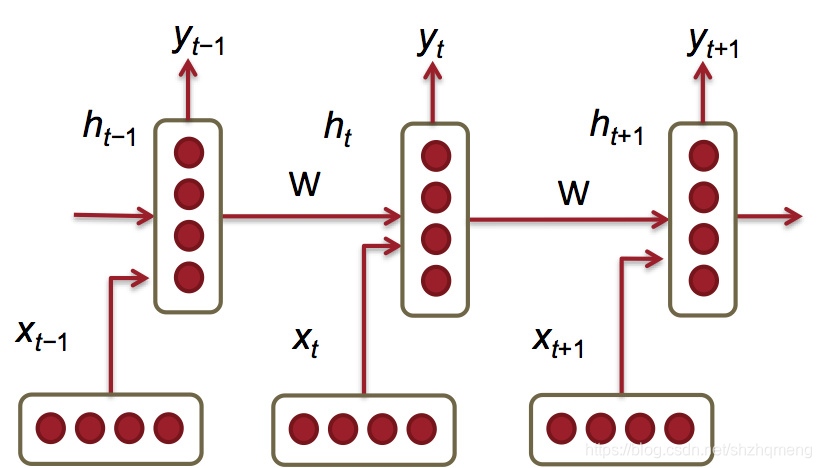Word Embedding 之CBOW
CBOW
CBOW 是一個非常優秀的Word Embedding模型,其原理非常簡單,本文章嘗試深入模型內部,探索這個模型的效能和表現。
模型結構
準備
再介紹模型的網路結構之前,首先要介紹的是一個向量計算。假定特徵為,
其中。我們定義一種計算,
。
其中,而。
換成tensorflow 的語言這個運算可以用下面的語言來描述
x = tf.placeholder(shape=[n, e], name='x', dtype=tf.float32) y = tf.reduce_mean(x, axis = 1)
文字數字化
本節我們來討論文字數字話的技術。大家都知道,文字本身在計算機看來是有一個編號和一個渲染邏輯的。當我們提到一個文字的時候,計算機看來,這個文字就是一個編號,這個編號現在用的最多的就是UTF-8編碼;當我們看到一個文字的時候,計算機會找到文字編號對應的渲染邏輯,在LCD活著LED螢幕上點燃文字點陣。文字的點燃矩陣和文字的編碼都是沒有數學屬性的,例如“美麗”和“漂亮”在上述的表示中沒有任何數學上的關聯。
為了克服上述問題,一個廣泛使用的方法是one-hot,假定漢語中總共有個字,第字用一個向量表示,這個向量中除了第個位置為1之外,其他的位置為。這樣一個句子就可以表示成n-hots 向量,這個向量具有一定的數學意義,在n-hots向量空間中夾角較小的句子有一定的語意相似性。
這種表示忽略了詞彙本身的特徵,沒有挖掘出其合適的數學表示來。為了挖掘這種特性,通常的做法是先將文字表示成one-hot,然後作為一個神經網路層的輸入。這個神經網路的輸出為一個維的向量,網路的行為可以用如下的數學公式表示
其中是詞的one-hot表示,是一個形狀為的矩陣。W的每一行為個從標準正態分佈中取樣的樣本。隨後值會被當成神經網路的輸入。神經網路將通過梯度下降法學習W的最終表示,作為預料中詞彙的合適數字表示。
構建損失函式
目前有很多種構建損失函式的方法,最早的方法是使用RNN,RNN的損失函式是通過預測下個一個詞的分佈來完成的。CBOW構建損失函式的方法是通過左右預測中間的方法。
基於RNN的方法

這種思路非常清晰,這裡就不贅述了。思路就是序列根據前面的序列預測下一個。
基於CBOW的方法
CBOW的思路是通過兩邊預測中間的詞。圖中的SUM函式就是我們在準備中介紹的向量化計算。就是文字數字化的輸出。

class WordEmbedding:
def __init__(self, embeding_size, vocabulary_size, window_size):
self.__graph = tf.Graph()
self.__session = tf.Session(graph=self.__graph)
self.__embeding_size = embeding_size
self.__vocabulary_size = vocabulary_size
self.__window_size = window_size
self.__epoch_num = 10
self.__embedding = None
def embedingInit(self, vocabulary_size, embeding_size, x_onehot):
embedding = tf.Variable(tf.random_uniform([vocabulary_size, embeding_size]))
self.__embedding = embedding
x_vec = tf.nn.embedding_lookup(embedding, x_onehot)
return x_vec
def graphCreate(self, x_vec):
hidden_state = tf.reduce_mean(x_vec, axis=1)
weight = tf.Variable(tf.truncated_normal(shape=[self.__embeding_size, self.__vocabulary_size]), dtype=tf.float32)
bias = tf.Variable(tf.truncated_normal(shape=[1, self.__vocabulary_size]), dtype=tf.float32)
y_logit = tf.matmul(hidden_state, weight) + bias
y_softmax = tf.nn.softmax(y_logit)
return y_logit, y_softmax
def calculateLoss(self, logits, labels):
cost_array = tf.nn.sparse_softmax_cross_entropy_with_logits(logits=logits, labels=labels)
return tf.reduce_sum(cost_array)
def create_graph(self, batch_size):
with self.__graph.as_default():
self.__batch_size = tf.placeholder(dtype=tf.int32, name='batch_size')
self.__x_ids = tf.placeholder(dtype=tf.int32, shape=[None, self.__window_size * 2], name="x_ids")
self.__x_labels = tf.placeholder(dtype=tf.int32, shape=[None], name="x_lables")
x_vec = self.embedingInit(self.__vocabulary_size, self.__embeding_size, self.__x_ids)
tf.add_to_collection("infer", x_vec)
y_logit, y_softmax = self.graphCreate(x_vec)
cost = self.calculateLoss(y_logit, self.__x_labels)
return cost, y_softmax
def train(self, batch_sample, batch_label):
batch_size = len(batch_sample[0])
cost, y_softmax = self.create_graph(batch_size)
with self.__graph.as_default():
train = tf.train.AdamOptimizer().minimize(cost)
self.__session.run(tf.global_variables_initializer())
for i in range(self.__epoch_num):
index_array = np.arange(len(batch_label))
random.shuffle(index_array)
for index in index_array:
if (len(batch_label[index]) != batch_size):
continue
_, lost_value = self.__session.run([train, cost],
feed_dict={
self.__batch_size: batch_size,
self.__x_ids:batch_sample[index],
self.__x_labels:batch_label[index]
}
)
print(lost_value)
save_path = tf.train.Saver(tf.trainable_variables(), max_to_keep=4).save(self.__session, "./data/model/model.ckpt")
print(save_path)
def infer(self, model_path):
saver = tf.train.import_meta_graph(model_path + ".meta")
with tf.Session() as sess:
saver.restore(sess, model_path)
y = tf.get_collection("infer")[0]
graph = tf.get_default_graph()
batch_size = graph.get_operation_by_name("batch_size").outputs[0]
ids = graph.get_operation_by_name('x_ids').outputs[0]
ret = sess.run(y, feed_dict={batch_size:[1], ids : [[2,3,4,5]]})
